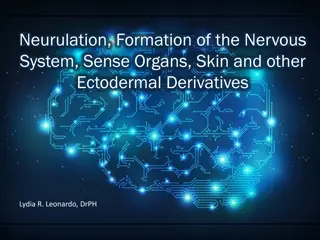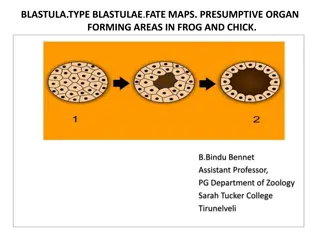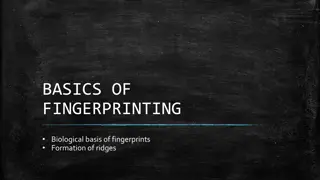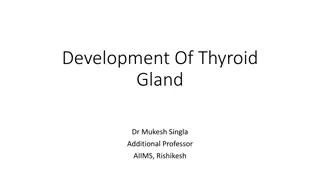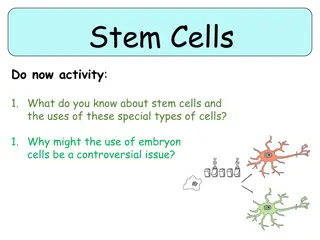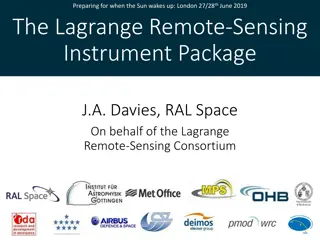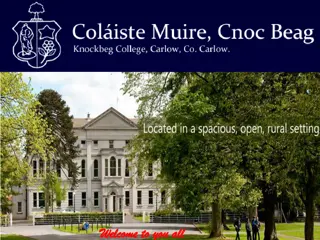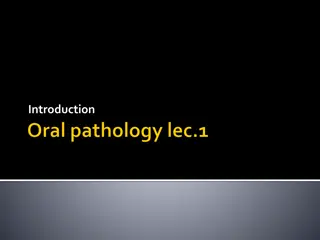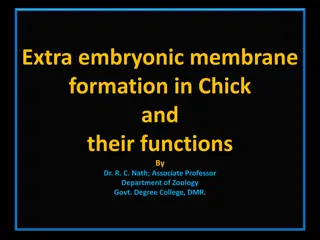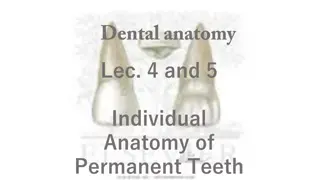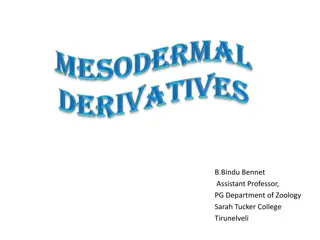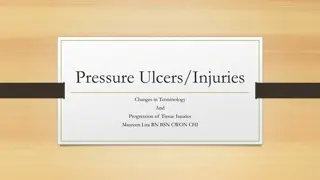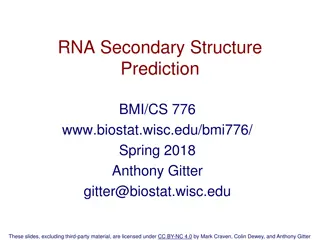Development of Maxillary Prominences and Secondary Palate in Embryonic Development
New outgrowths from the medial edges of the maxillary prominences form the shelves of the secondary palate. Fusion of these palatal shelves involves complex cellular changes, such as elevation after the withdrawal of the tongue and alterations in epithelium leading to adhesion and fusion. The fate of remaining epithelial cells is debated, with some undergoing cell death while others transform into mesenchymal cells. Ultimately, the hard palate and soft palate originate from the secondary palate. Additionally, the development of visceral arches and the pituitary gland, derived partly from interactions between the ventral forebrain and oral ectoderm, are vital in embryonic development.
Download Presentation

Please find below an Image/Link to download the presentation.
The content on the website is provided AS IS for your information and personal use only. It may not be sold, licensed, or shared on other websites without obtaining consent from the author.If you encounter any issues during the download, it is possible that the publisher has removed the file from their server.
You are allowed to download the files provided on this website for personal or commercial use, subject to the condition that they are used lawfully. All files are the property of their respective owners.
The content on the website is provided AS IS for your information and personal use only. It may not be sold, licensed, or shared on other websites without obtaining consent from the author.
E N D
Presentation Transcript
Development of maxillary prominences and secondary palate:
New outgrowths from the medial edges of the maxillary prominences form the shelves of the secondary palate. These palatal shelves grow downward beside the tongue, at which time the tongue partially fills the nasal cavities. At about the ninth gestational week; the shelves elevate, make contact, and fuse with each other above the tongue. In the anterior region, the shelves are brought to the horizontal position by a rotational (hinge like) movement. In the more posterior regions, the shelves appear to alter their position by changing shape (remodeling) as well as by rotation.
Available evidence indicates that the shelves are incapable of elevation until the tongue is first withdrawn from between them. Fusion of palatal shelves requires alterations in the epithelium of the medial edges that begin prior to elevation. These alterations consist of cessation of cell division, which appears to be mediated through distinct underlying biochemical pathways, including a rise in cyclic AMP levels. There is also loss of some surface epithelial (peridermal) cells and production of extracellular surface substances, particularly glycoproteins, that appear to enhance adhesion between the shelf edges as well as between the shelves and inferior margin of the nasal septum.
The ultimate fate of these remaining epithelial cells is controversial. Some of them appear to undergo cell death and eventually are phagocytized, but many undergo direct transformation in mesenchymal cells. Some of the epithelial cells remain indefinitely in clusters (cell rests) along the fusion line. Eventually, most of the hard palate and all of the soft palate form from the secondary palate.
Development of visceral arches and tongue The pituitary gland develops as a result of inductive interactions between the ventral forebrain and oral ectoderm and is derived in part from both tissues Following initial neural crest cell migration , these cells invade the area of the developing pituitary gland and are continuous with cells that will later form the maxillary prominence. Eventually, neural crest cells form the connective tissue components of the gland.
In humans there is a total of six visceral arches, of which the fifth is rudimentary. These arches are also known as pharyngeal or branchial arches. The gills (branchii) of the fish are modified to give rise to these arches. The proximal portion of the first (mandibular) arch becomes the maxillary prominence.As the heart recedes caudally; the mandibular and hyoid arches develop further at their distal portions to become consolidated in the ventral midline.
As noted previously, the mesodermal core of each visceral arch is concerned primarily with the formation of vascular endothelial cells. As noted below, these cells appear to be later replaced by cells that eventually form visceral arch myoblasts. The first (mandibular) and second (hyoid) visceral arches undergo further developmental changes. As the heart recedes caudally, both arches send out bilateral processes that merge with their opposite members in the ventral midline. Nerve fibers from the fifth, seventh, ninth, and tenth cranial nerves extend into the mesoderm of the first four visceral arches.
The mesoderm of the definitive mandibular and hyoid arches gives rise to the fifth and seventh nerve musculature, while mesoderm associated with the less well developed third and fourth arches forms the ninth and tenth nerve musculature. Myoblast cells in the visceral arches actually originate from mesoderm more closely associated with the neural tube (cells that form the hypoglossal and extrinsic eye musculature).
They would then migrate into the visceral arches and replace the mesodermal cells that initiated blood vessel formation earlier. It therefore appears that myoblasts forming voluntary striated muscle fibers of the facial region would then originate from mesoderm adjacent to the neural tube. Groups of visceral arch myoblasts that are destined to form individual muscles each take a branch of the appropriate visceral arch nerve.
Myoblasts from the second visceral arch, for example, take branches of the seventh cranial nerve and migrate very extensively throughout the head and neck to form the contractile components of the muscles of facial expression. Myoblasts from the first arch contribute mostly to the muscles of mastication, while those from the third and fourth arches contribute to the pharyngeal and soft palate musculature.
Connective tissue components of each muscle in the facial region are provided by mesenchymal cells of crest origin. The crest mesenchymal cells of the visceral arches give rise to skeletal components such as the temporary visceral arch cartilages (e.g., Meckel s cartilage, middle ear cartilages, and mandibular bones).
Also visceral arch crest cells form connective tissues such as dermis and the connective tissue components of the tongue. The tongue forms in the ventral floor of the pharynx after arrival of the hypoglossal muscle cells. The lateral lingual tubercles or swellings form the tongue has not been carefully documented. It is known that the anterior two thirds of the tongue is covered by ectoderm whereas endoderm covers the posterior one third.
The thyroid gland forms by invagination of the most anterior endoderm (thyroglossal duct). A residual pit (the foramen cecum) left in the epithelium at the site of invagination marks the junction between the anterior two thirds and posterior one third of the tongue, which are, respectively, covered by epithelia of ectodermal and endodermal origin. It is also known that the connective tissue components of the anterior two thirds of the tongue are derived from first-arch mesenchyme,
Where as those of the posterior one third appear to be primarily derived from the third-arch mesenchyme. The epithelial components of a number of glands are derived from the endodermal lining of the pharynx. In addition to the thyroid, these include the parathyroid and thymus. The epithelial components of the salivary and anterior pituitary glands are derived from oral ectoderm.
Finally, a lateral extension from the inner groove between the first and second arch gives rise to the eustachian tube, which connects the pharynx with the ear. The external ear, or pinna, is formed at least partially from tissues of the first and second arches .
FINAL DIFFERENTIATION OF FACIAL TISSUES The extensive cell migrations referred to above bring cell populations into new relationships and lead to further inductive interactions, which, in turn, lead to progressively more differentiated cell types. For example, some of the crest cells coming into contact with pharyngeal endoderm are induced by the endoderm to form visceral arch cartilages. Recent studies indicate the early epithelial interactions are also involved in bone formation. The exact interactions involved in tooth formation are somewhat controversial.
Mesenchymal cells of crest origin must be involved, and these cells form the dental papilla and the mesenchyme surrounding the epithelial enamel organ. Whether the epithelium or mesenchyme is initially responsible for determining which tooth (e.g., incisor or molar) forms from a tooth germ is controversial.
only crest mesenchymal cells and not mesodermal mesenchymal cells will respond to inducing tissues such as pharyngeal endoderm. In other cases, as in the differentiation of dermis and meninges, it appears that the origin of the mesenchyme is of no consequence.
The formation of skeletal and connective tissues, ordinarily performed by mesodermal cells in other regions, has been occupied by neural crest cells in the facial region. The crest cells therefore play a very dominant role in facial development, since they form all nonepithelial components except endothelial cells and the contractile elements of skeletal (voluntary) muscle. The onset of bone formation or the establishment of all the organ systems (about the eighth week of development) is considered the termination of the embryonic period.





